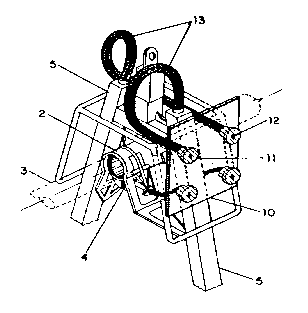Some of the information on this Web page has been provided by external sources. The Government of Canada is not responsible for the accuracy, reliability or currency of the information supplied by external sources. Users wishing to rely upon this information should consult directly with the source of the information. Content provided by external sources is not subject to official languages, privacy and accessibility requirements.
Any discrepancies in the text and image of the Claims and Abstract are due to differing posting times. Text of the Claims and Abstract are posted:
| (12) Patent: | (11) CA 2129563 |
|---|---|
| (54) English Title: | INTERFACE SYSTEM FOR OPERATION OF REMOTE CONTROL VEHICLE |
| (54) French Title: | SYSTEME D'INTERFACE POUR LE FONCTIONNEMENT D'UN VEHICULE TELECOMMANDE |
| Status: | Term Expired - Post Grant Beyond Limit |
| (51) International Patent Classification (IPC): |
|
|---|---|
| (72) Inventors : |
|
| (73) Owners : |
|
| (71) Applicants : |
|
| (74) Agent: | GOWLING WLG (CANADA) LLPGOWLING WLG (CANADA) LLP |
| (74) Associate agent: | |
| (45) Issued: | 2000-05-02 |
| (22) Filed Date: | 1994-08-05 |
| (41) Open to Public Inspection: | 1995-10-01 |
| Examination requested: | 1996-09-20 |
| Availability of licence: | N/A |
| Dedicated to the Public: | N/A |
| (25) Language of filing: | English |
| Patent Cooperation Treaty (PCT): | No |
|---|
| (30) Application Priority Data: | |||||||||
|---|---|---|---|---|---|---|---|---|---|
|
The present invention provides for an interface system allowing centralisation of all points at which torque is usually applied to subsea equipment, particularly equipment employed in the search for and production of oil. Heretofore is provided a single panel upon which standard kinds of connecting terminals fitted with sockets are mounted. The terminals are connected with corresponding torque application points on the equipment by torque transfer means and correspondingly marked, thus enhancing accessibility by remote operated vehicles. Individual connection between torque application points and the sockets on the panel is achieved by means of flexible devices, i.e. non-twisting metal cables.
La présente invention concerne un système d'interface permettant la centralisation de tous les points où le couple est généralement appliqué aux équipements sous-marins, en particulier le matériel utilisé dans la recherche et la production de pétrole. Jusqu'ici il est prévu un seul panneau sur lequel des types standards de bornes équipées de prises de raccordement sont montées. Les bornes sont reliées à des points d'application de couple correspondants sur l'appareil par des moyens de transfert de couple et marquées de façon correspondante, améliorant ainsi l'accessibilité par les véhicules télécommandés. Le raccordement individuel entre les points d'application de couple et les prises sur le panneau est réalisé au moyen de dispositifs flexibles, c.-à-d. des câbles métalliques non torsadés.
Note: Claims are shown in the official language in which they were submitted.
Note: Descriptions are shown in the official language in which they were submitted.

2024-08-01:As part of the Next Generation Patents (NGP) transition, the Canadian Patents Database (CPD) now contains a more detailed Event History, which replicates the Event Log of our new back-office solution.
Please note that "Inactive:" events refers to events no longer in use in our new back-office solution.
For a clearer understanding of the status of the application/patent presented on this page, the site Disclaimer , as well as the definitions for Patent , Event History , Maintenance Fee and Payment History should be consulted.
| Description | Date |
|---|---|
| Inactive: Expired (new Act pat) | 2014-08-05 |
| Inactive: IPC from MCD | 2006-03-11 |
| Inactive: IPC from MCD | 2006-03-11 |
| Inactive: IPC from MCD | 2006-03-11 |
| Inactive: IPC from MCD | 2006-03-11 |
| Grant by Issuance | 2000-05-02 |
| Inactive: Cover page published | 2000-05-01 |
| Letter Sent | 2000-02-17 |
| Inactive: Final fee received | 2000-01-11 |
| Pre-grant | 2000-01-11 |
| Inactive: Correspondence - Prosecution | 1999-12-09 |
| Letter Sent | 1999-12-01 |
| Notice of Allowance is Issued | 1999-12-01 |
| Notice of Allowance is Issued | 1999-12-01 |
| Inactive: Status info is complete as of Log entry date | 1999-11-19 |
| Letter sent | 1999-11-19 |
| Advanced Examination Determined Compliant - paragraph 84(1)(a) of the Patent Rules | 1999-11-19 |
| Inactive: Application prosecuted on TS as of Log entry date | 1999-11-19 |
| Inactive: Approved for allowance (AFA) | 1999-11-17 |
| Inactive: Advanced examination (SO) fee processed | 1999-11-12 |
| Inactive: Advanced examination (SO) | 1999-11-12 |
| All Requirements for Examination Determined Compliant | 1996-09-20 |
| Request for Examination Requirements Determined Compliant | 1996-09-20 |
| Application Published (Open to Public Inspection) | 1995-10-01 |
There is no abandonment history.
The last payment was received on 1999-05-26
Note : If the full payment has not been received on or before the date indicated, a further fee may be required which may be one of the following
Please refer to the CIPO Patent Fees web page to see all current fee amounts.
Note: Records showing the ownership history in alphabetical order.
| Current Owners on Record |
|---|
| PETROLEO BRASILEIRO S.A. - PETROBRAS |
| Past Owners on Record |
|---|
| CARLOS HENRIQUE GUIMARAES DA CUNHA |
| NEY ROBINSON SALVI DOS REIS |